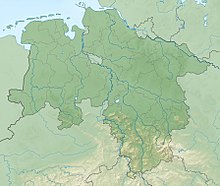Ihlower Forest
The Ihlow Forest is a 350 hectare large forested area in the field of collective municipality in East Friesland. Today it is mainly made up of beeches, oaks and other deciduous trees. Conifers are rather rare here. The forest became known in particular through the excavations at the former Cistercian monastery .
Land use, soil
The forest floor consists mainly of sediment sand . In a few places there is a moor layer that has been largely drained through systematic drainage and the associated lowering of the groundwater level. As a result, the forest is criss-crossed by an extensive system of ditches. In the immediate vicinity of the former monastery there are fish ponds that were created by monks to supply the monastery. In places today rewetting is carried out.
The majority of the forest is now staatsforstlich used. 7.5 percent of the area is designated as natural forest .
Flora and fauna
In the forest , populations of trees dominated by common oaks and red beeches predominate. Black alders and ash trees can be found on the moorland . The few coniferous areas are dominated by spruce .
The animals include wild species such as roe deer and fallow deer , foxes , hares and badgers .
history
The forest is the namesake of the community. The forest was first mentioned in the 13th century when renegade monks of the Benedictine order from the Meerhusen double monastery asked to be accepted into the Cistercian order. However, this was only permitted on the condition that a new monastery was built for the monks, while the nuns were to remain in the Meerhusen monastery. A place ter Yle , zu Ihlow (in the Yl-loh , the yew forest) was chosen as the location for the monastery . The monks cultivated the forest and created a clearing and several fish ponds in the immediate vicinity of the monastery. In the course of the Reformation , the possessions of the East Frisian monasteries, monasteries and comers, and thus also the Ihlower Forst, fell to the Counts and Princes of East Frisia , who used it as a hunting ground and had a hunting lodge built here from the ruins of the monastery.
East Frisia is poor in forests. One of the oldest maps from 1579 shows only eight forests in the region, one of which is Ihlow. At that time the forest extended over an area of about 180 hectares. In 1731 the forest was then expanded through the purchase of land. After the Cirksena became extinct , the Prussians became lords of East Frisia. They began with the orderly use of the forest. After the French occupied East Frisia , the few East Frisian forests were almost completely cut down. The material was needed for the construction of ski jumps on the East Frisian Islands, such as the Napoleon ski jump on Norderney . After the withdrawal of the French, reforestation began and the forest was significantly expanded by planting the domain land , so that it now extends to almost 315 hectares.
Individual evidence
- ↑ a b Ihlow Tourism: Ihlow am Ihler Meer ( Memento of the original from January 23, 2016 in the Internet Archive ) Info: The archive link has been inserted automatically and has not yet been checked. Please check the original and archive link according to the instructions and then remove this notice. , P. 4 (PDF file).
- ↑ a b Dr. Jens-Hermann Stuke: Hoverflies Ostfriesland - a first compilation of current observations (Diptera: Syrphidae) , Oldenburg 2001.
- ^ Bernhard Buttjer; Martin Stromann: Where the monks once lived: The Ihlow monastery, a forest and twelve villages . Verlag SKN, Norden (Ostfriesland) 2009, ISBN 3-939870-22-6 , p. 90.
- ^ Buttjer, Stromann, p. 92
literature
- Bernhard Buttjer; Martin Stromann: Where the monks once lived: The Ihlow monastery, a forest and twelve villages . Verlag SKN, Norden (Ostfriesland) 2009, ISBN 3-939870-22-6
Coordinates: 53 ° 24 ′ 14.1 ″ N , 7 ° 27 ′ 31.9 ″ E

